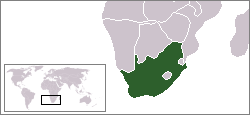Mapungubwe National Park
|
Mapungubwe National Park
|
|
|
Mapungubwe Hill |
|
| location | South Africa |
| surface | 15,237 ha |
| WDPA ID | 308687 |
| Geographical location | 22 ° 14 ′ S , 29 ° 13 ′ E |
| Setup date | 1947 |
| administration | South African National Parks |
The Mapungubwe National Park ( English Mapungubwe National Park ) is a national park in South Africa . It is located within the Mapungubwe cultural landscape , which has been a UNESCO World Heritage Site since 2003 . The park is characterized by a high biodiversity, striking rocks and the existence of archaeological sites. Together with areas in South Africa, Botswana and Zimbabwe , it forms the Greater Mapungubwe Transfrontier Conservation Area .
description
The park is located on the border triangle between South Africa, Botswana and Zimbabwe.
A highly developed civilization flourished between 1200 and 1270 in what was then the city of Mapungubwe on the Mapungubwe Hill . Beginning around the year 900, the area was inhabited by a people who were already working iron and who had become prosperous through trade with Egypt , India and China . Archaeologists found the "Golden Rhinoceros" and other evidence of a rich kingdom here.
Sandstone cliffs, Mopane - and alluvial forests and Baobab trees (baobabs) dot the landscape, home to a diverse wildlife is. Elephants, giraffes, white rhinos (including white rhinos), elen and oryx as well as numerous other antelope species have their natural habitat here. Lions, leopards and hyenas also live in the area. Bustards , flute Strangler (Southern boubous) and Pel's fishing owl among the more than 400 species of birds that make their home here.
The three states involved in the cross-border conservation area signed a memorandum with guidelines for the Limpopo - Shashe Transfrontier Conservation Area . In 2009 it was renamed the Greater Mapungubwe Transfrontier Conservation Area . In addition to the Mapungubwe National Park and the Venetia Limpopo Nature Reserve in South Africa, it consists of the Tuli Block in Botswana and the Tuli Safari Area in Zimbabwe. The aim is to dispense with border fences within the park area. On the South African side, a hard coal mine was to be built in the immediate vicinity of the park area in 2011. However, these plans were stopped after protests.
Sandstone cliffs in Mapungubwe National Park
Web links
- South African National Parks: Mapungubwe National Park . National park administration website at www.sanparks.org (English)
- Siyabona Africa: Mapungubwe National Park, Limpopo (English)
- SuedafrikaTour.de: Mapungubwe National Park
- World Database on Protected Areas - Mapungubwe National Park (English)
Individual evidence
- ↑ Claus Stäcker: Coal instead of culture , South Africa's threatened world cultural heritage Mapungubwe. Contribution of the background series , Deutschlandfunk, November 7, 2011






